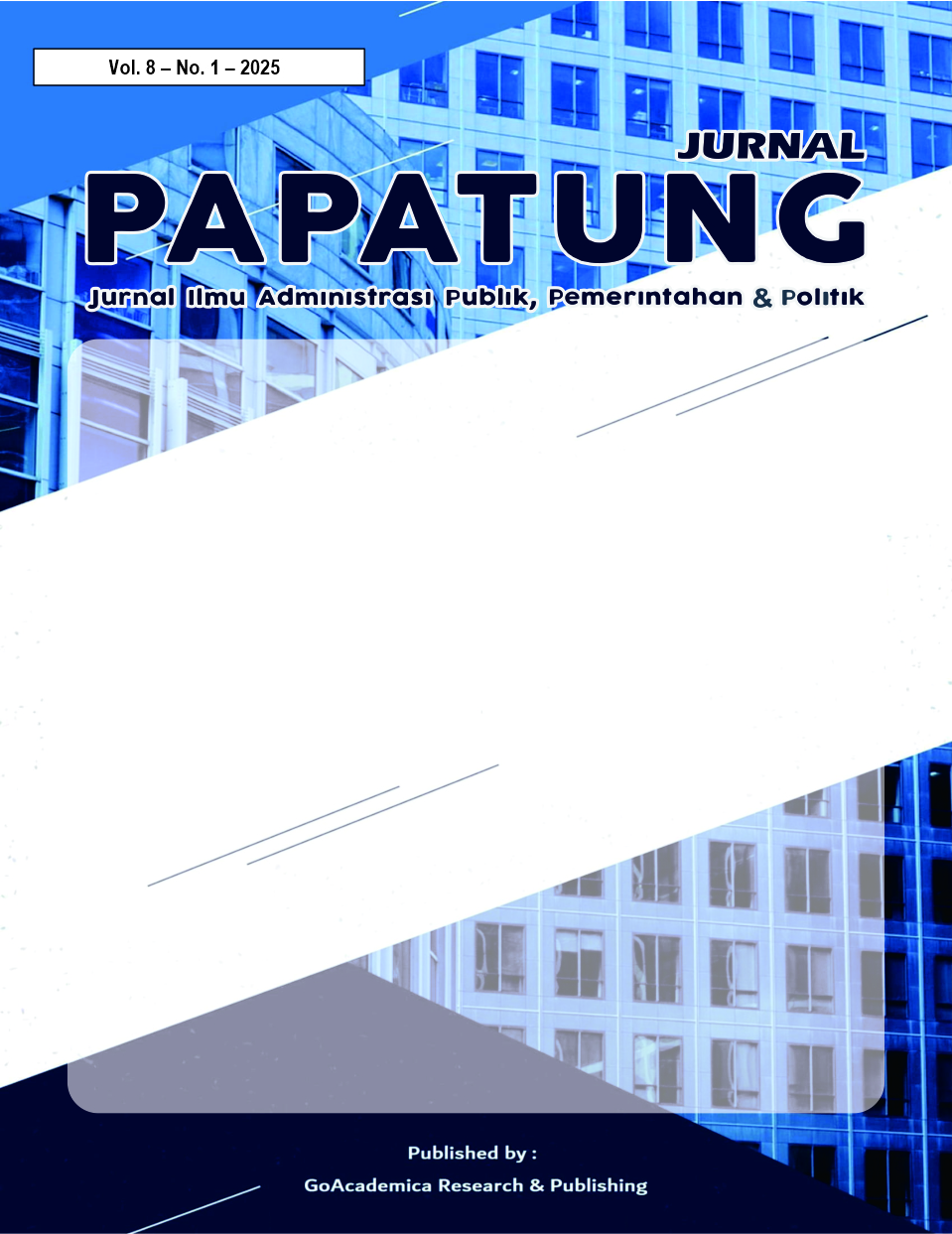THE INFLUENCE OF ICONIC AND CULTURALLY ROOTED POLICE BUILDINGS ON PUBLIC TRUST: A QUALITATIVE STUDY AT THE TANJUNG BATU POLICE SECTOR
Abstract
Public trust in the police institution is a crucial element in maintaining social order and institutional legitimacy. In recent years, efforts to humanize public services through architectural design have gained increasing attention, particularly amid growing public skepticism toward the Indonesian National Police (Polri). This study aims to explore how iconic police building designs rooted in local culture influence public trust through symbolic and cultural representation. A qualitative approach with a single-case study design was employed, focusing on the Integrated Police Service Center (SPKT) of the Tanjung Batu Police Sector, which features distinctive architectural elements such as traditional roof structures, local wood materials, and regional cultural ornaments. Data were collected through in-depth interviews, field observations, and visual documentation. The findings reveal that these architectural elements foster emotional connection, a sense of comfort, and public perceptions of openness and professionalism within the police institution. These results highlight the importance of integrating local identity into public service infrastructure design as a strategic effort to build public trust and strengthen institutional credibility.
References
Bharata, A. A. (2003). Pelayanan Publik: Konsep dan Implementasinya. Bandung: Citra Umbara.
Blumer, H. (1969). Symbolic Interactionism: Perspective and Method. Englewood Cliffs, NJ: Prentice-Hall.
Carey, J. W. (2004). Cultural studies and symbolic interactionism: Notes in critique and tribute to Norman Denzin. Emerald (MCB UP).
Chen, S. L. S (2004). Cultural studies and symbolic interactionism: NCA spotlight on the contributions of Norman Denzin. Emerald (MCB UP).
DEWI, RP (2019). Case Study - Qualitative Research Methods. Center for Open Science.
Dovey, K. (2010). Becoming Places: Urbanism/Architecture/Identity/Power. London: Routledge.
Evans, G. W., & McCoy, J. M. (1998). When buildings don't work: The role of architecture in human health. Journal of Environmental Psychology, 18(1), 85–94.
Fernback, J. (2019). Symbolic Interactionism in Communication. Oxford University Press.
Gifford, R. (2014). Environmental Psychology: Principles and Practice. Colville, WA: Optimal Books.
Gilling, D. (2007). Partnership and Crime Prevention: Some Reflections on the Role of the Police. Routledge.
Heath, T. (2006). Interface: Architecture and the Construction of Meaning. Lisbon: Hogrefe Publishing.
Hedges, H. (2020). The place of interests, agency and imagination in funds of identity theory. Informa UK Limited.
Hodos, T. (2010). Local and global perspectives in the study of social and cultural identities. Retrieved from: https://research-information.bris.ac.uk/files/5149092/Local_Global_Social_Cultural_Identities.pdf
Jencks, C. (2005). The Iconic Building: The Power of Enigma. London: Frances Lincoln.
Kasmir. (2006). Customer Service Ethics. Jakarta: Rajawali Pers.
Kochel, T.R. (2021). Accountability and transparency as levers to promote public trust and police legitimacy: findings from a natural experiment. Policing, 44(6), 1046–1059. https://doi.org/10.1108/PIJPSM-04-2021-0062
Lewicki, R. J., & Tomlinson, E. C. (2003). Trust and trust building. In Beyond intractability. Conflict Research Consortium….
Loader, I., & Walker, N. (2020). Policing and the public: Trust and distrust in law enforcement. Oxford University Press.
Malone, M. F. T. (2021). The police and the public: policing practices and public trust in Latin America. Policing and Society, 31(4), 418–433. https://doi.org/10.1080/10439463.2020.1744600
Marques, S., Lima, M.L., Moreira, S., & Reis, J. (2015). Local Identity Measure. In PsycTESTS Dataset. American Psychological Association (APA). https://doi.org/10.1037/t46994-000
Mayer, R. C., Davis, J. H., & Schoorman, F. D. (1995). An Integrative Model of Organizational Trust. Academy of Management Review, 20(3), 709–734.
Mawby, R.I. (2022). Community policing and public trust in the UK: A qualitative study. Cambridge University Press.
Mourtgos, S. M. (2020). The Overlooked Perspective of Police Trust in the Public: Measurement and Effects on Police Job Behaviors. Criminal Justice Policy Review, 31 (5), 639–672. https://doi.org/10.1177/0887403419851850
Perry, G. (2020). Expectations, Effectiveness, Trust, and Cooperation: Public Attitudes towards the Israel Police during the COVID-19 Pandemic. Policing (Oxford), 14(4), 1073–1091. https://doi.org/10.1093/police/paaa060
Poltak, H., & Widjaja, RR (2024). Case Study Method Approach in Qualitative Research. In Local Engineering (Vol. 2, Issue 1, pp. 31–34). CV. Gio Architect. https://doi.org/10.59810/lejlace.v2i1.89
Pryce, D. K. (2022). Race differences in public satisfaction with and trust in the local police in the context of george floyd protests: an analysis of residents' experiences and attitudes. Criminal Justice Studies, 35(1), 74–92. https://doi.org/10.1080/1478601X.2021.1981891
Proshansky, H.M. (1978). The City and Self-Identity. Environment and Behavior, 10(2), 147–
Rapoport, A. (1982). The Meaning of the Built Environment: A Nonverbal Communication Approach. Beverly Hills, CA: Sage Publications.
Richards, G. (2007). Cultural tourism: Global and local perspectives. https://books.google.com/books?hl=en&lr=&id=-LXgdr3hbkgC&oi=fnd&pg=PR13&dq=local+culture&ots=QHqo5ysYRI&sig=wxGHmJidIXwg9c3FhxN9jY9CnEA
Rusandi, & Rusli, M. (2021). Designing Basic/Descriptive Qualitative Research and Case Studies. In Al-Ubudiyah: Journal of Islamic Education and Studies (Vol. 2, Issue 1, pp. 48–60). Darud Dakwah Wal Irsyad Islamic College Makassar. https://doi.org/10.55623/au.v2i1.18
Skandalis, A., Banister, E., & Byrom, J. (2017). The spatial aspects of musical taste. In Marketing Theory (Vol. 18, Issue 2, pp. 249–265). SAGE Publications. https://doi.org/10.1177/1470593117732464
Snow, D. A. (2001). Interactionism: Symbolic. In International Encyclopedia of the Social & Behavioral Sciences (pp. 7695–7698). Elsevier. https://doi.org/10.1016/b0-08-043076-7/01905-7
Suchman, M. C. (1995). Managing Legitimacy: Strategic and Institutional Approaches. Academy of Management Review, 20(3), 571–610.
Vitolla, F., & Rubino, M. (2017). Legitimacy theory and sustainability reporting. Evidence from Italy. In 10th Annual Conference of the EuroMed … . researchgate.net. https://www.researchgate.net/profile/Michele-Rubino-2/publication/324263149_Legitimacy_theory_and_sustainability_reporting_Evidence_from_Italy/links/5ac7e4a80f7e9bcd5193de70/Legitimacy-theory-and-sustainability-reporting-Evidence-from-Italy.pdf
Xinjian, W., & Yao, Z. (2024). Symbolic Interactionism. In The ECPH Encyclopedia of Psychology (pp. 1479–1480). Springer Nature Singapore. https://doi.org/10.1007/978-981-97-7874-4_387








.png)
.png)

1.png)
